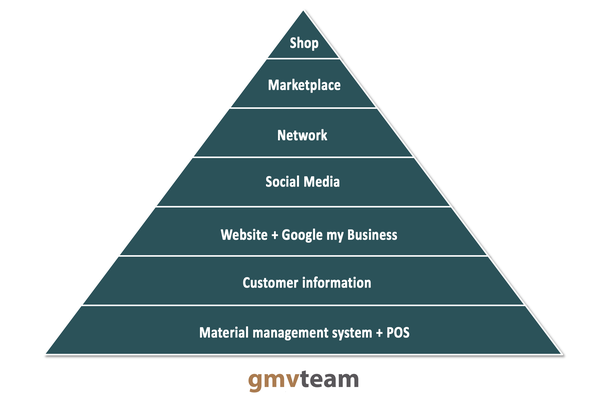Despite the many disasters that have come with Covid-19, the pandemic also brought a much-needed boost to digitalisation across all industries. Home schooling has been prohibited since compulsory schooling became mandatory. Today, the educational system’s answer to the pandemic is home schooling and many employers have found a new friend in allowing their employees to work from home. Faced with a lockdown, retailers have learned that mobilising shoppers through digital channels is a crucial key to success. Now is the time to get going.
But caution is called for: A certain approach should always be maintained. Based on the hierarchy of needs, these are the steps you should follow.

Step 1) Material management + POS
A good 30 – 40 % of the roughly 250,000 owner-managed retail stores in Germany do not have a material management system in place even though a point-of-sale system is mandatory by law. In the eyes of many experts, material management is the key component in the success of a business. It generates information from the data received which help to manage the business: Information about inventory levels, storage locations, tied capital, suppliers, and order processing are accessible at the touch of button. Those wishing to develop their format professionally and more importantly, with an eye towards the future, will find that there is no way around such an infrastructure. Retailers need data on themselves. Not knowing where one is at any given time makes it impossible to choose the right path forward.
Step 2) Know your customer
Without information about the customer base, it is impossible to efficiently mobilise customers. The baseline for this is a solid customer database which is often already pre-integrated into many material management systems. Once retailers know who buys what, when, and how, they can send personalised offers via different channels to mobilise their customers.
Step 3) Website + Google my Business
Having an independent webpage is a must. A solid 38 % of customers prepare their in-store buys online. This is where Google comes into play. Retailers can register with Google my Business to become digitally visible on a basic and healthy level. Google will then at least know of your existence. The Grow my Store programme offers a free analysis of one’s own website. This is then followed by proposals on how to improve one’s digital visibility.
Step 4) Social media
To sell means to fight for being seen. If no one sees you, no one can buy from you. Therefore, it is essential for retailers to try to be precisely where people are most likely found these days: on social media. Never has it been easier to come into contact with a group of potential customers and inform them of one’s own capabilities. At the same time, the evaluation of the target group approach is very easy and efficient – and definitely worth the effort!
Step 5) Network, network, network
Once the baseline for digitalisation has been created, the next step is to network with other retailers or services. Event-driven consumption is the magic word here. For example, a digital tour covering the ‘back to school’ theme could be organised. The toy and confectionery shop for the school starter’s goodies, the hairdresser and the clothes store for good styling and a photographer can merge forces with a virtual full-service offering.
Step 6) Selling on a marketplace
Once you have reached a good level of digital maturity, you can sell online. The first step should be through a marketplace which often takes a few steps only. For this, almost all providers offer informative tutorials showing how to conveniently access the market. The breadth of services is varied: On request, some providers take on the entire fulfilment for an order all the way to the delivery, which naturally impacts the commissions.
Step 7) Your own online shop
You are the master of your own online shop. But that comes with a full set of responsibilities! Retailers must be familiar with the technology behind a shop system – they must know how to optimise search engine searches while designing their marketing. This naturally comes with a certain effort. The advantage, however, is that the retailer can activate a completely new sales channel and mobilise groups of customers which had not been reached so far.
Copy From Internet Resources
Post time: Apr-28-2021




